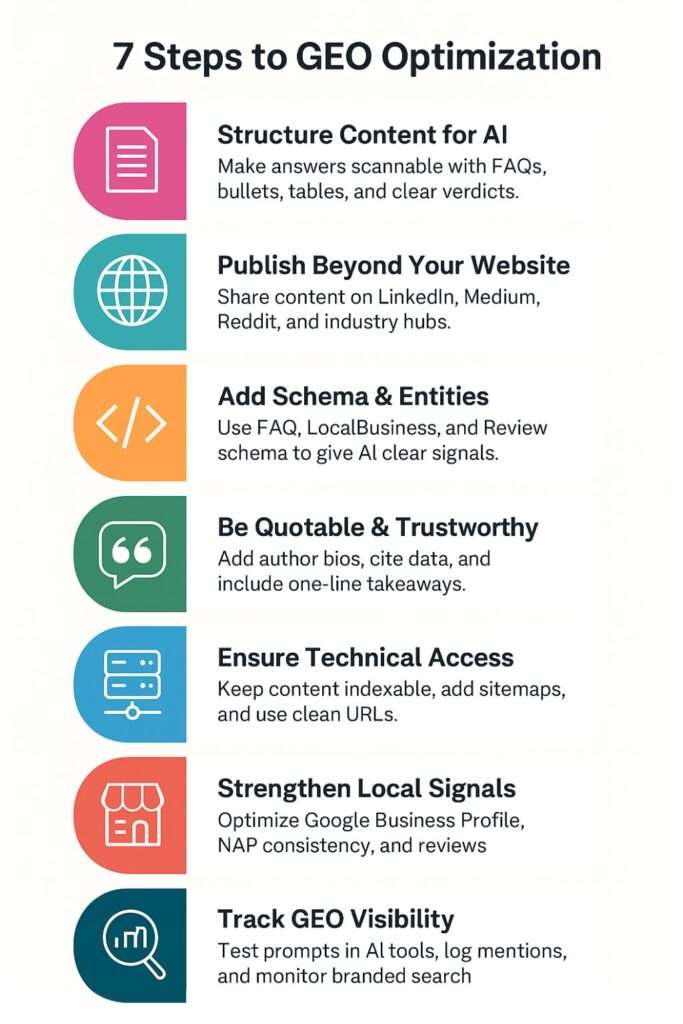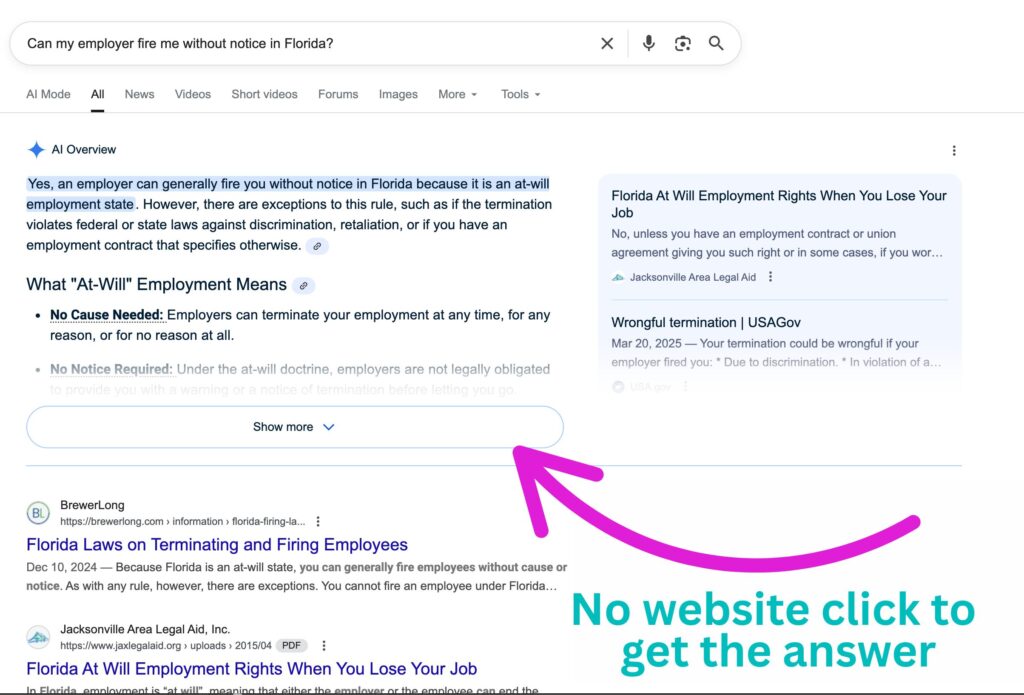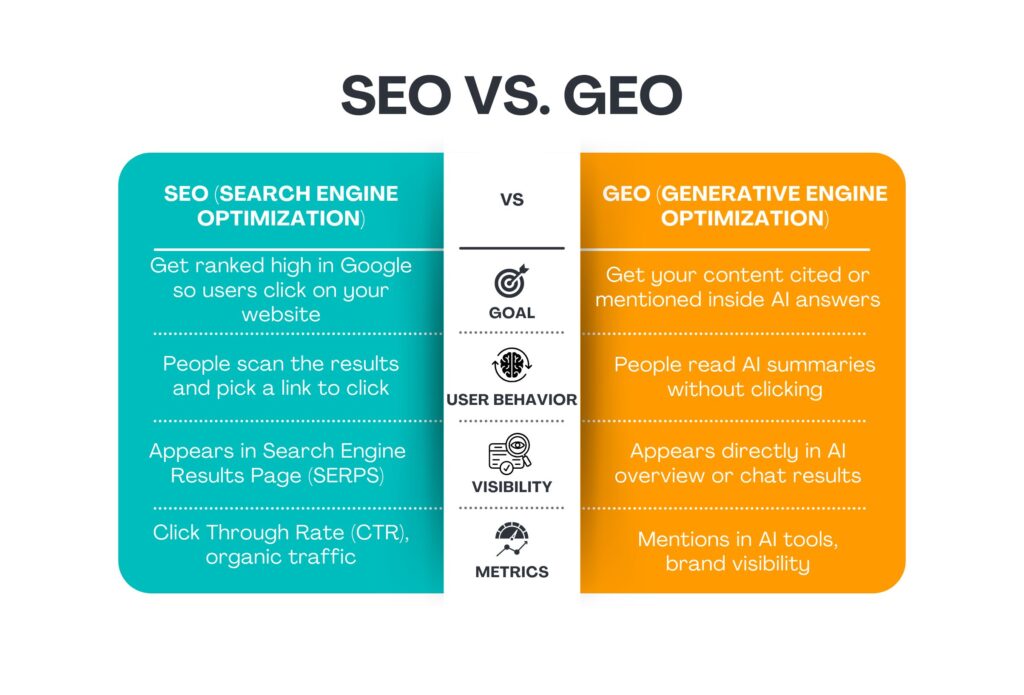Showing up first on Google doesn’t mean what it used to. In fact, clicks on the top result have dropped by almost a third since Google started rolling out AI summaries. Even the sites that used to dominate page one are seeing way fewer visits because people are just reading the AI answer instead of clicking through.
And this isn’t rare — those AI summaries are showing up in nearly one out of every three searches, and in most cases where someone is asking a question or looking to solve a problem.
So here’s the hard truth: if your content isn’t built to be the answer inside those AI responses, your business might be invisible… even if you think you’re ranking.”
Example: Google’s AI Overview Answering Legal Questions
When you Google a legal question like “Can my employer fire me without notice in Florida?”, the very first thing you see isn’t a website link — it’s Google’s AI Overview.
That box at the top gives a clear, direct answer: “Yes, an employer can generally fire you without notice in Florida because it is an at-will employment state.” It even lists exceptions.
Notice what’s missing? The need to click through.
The user’s question is answered right there on the page.
The AI pulls in information from multiple sites, but instead of sending traffic to those websites, it condenses the answer and keeps the user in Google’s ecosystem.
Only if someone wants to dive deeper would they scroll down and click a link — but most people won’t.
Why AI Overviews Steal Website Traffic
Zero-click searches are now the norm. The AI summary gives people enough of an answer to stop searching.
Even if your firm wrote one of the cited sources, you may never see the traffic.
For legal, medical, and financial questions especially, users are more likely to skim the AI box and move on.
This changes the playbook. Ranking on page one isn’t enough anymore.
The real strategy is making sure AI engines like ChatGPT, Gemini, and Google’s own AI Overviews are pulling your content when they answer a question. That strategy is called GEO — and it’s quickly becoming just as important as SEO.
Generative Engine Optimization (GEO) is all about making sure your business shows up inside AI-generated answers, not just on Google’s list of links. Instead of focusing only on ranking high in search results, GEO is about structuring your content so tools like Google’s AI Overviews, ChatGPT, and Gemini see it as the best possible answer. Think of it this way: SEO gets people to click, but GEO makes sure you’re the answer even when no one clicks at all.
SEO vs. GEO Comparison Table
| Aspect | SEO (Search Engine Optimization) | GEO (Generative Engine Optimization) |
|---|---|---|
| Main Goal | Get ranked high in Google so users click to your website | Get your content cited or mentioned inside AI answers |
| User Behavior | People scan results and choose a link to click | People read AI summaries without clicking |
| Visibility | Appears in search engine results pages (SERPs) | Appears directly in AI Overviews or chat responses |
| Tactics | Keywords, backlinks, page speed, mobile optimization, schema | FAQs, listicles, comparison tables, structured content, publishing on AI-friendly platforms |
| Metrics | Click-through rate (CTR), organic traffic, keyword rankings | Mentions in AI tools, brand visibility, branded searches (even without clicks) |
| Timeframe | Long-term, ongoing | Emerging, with first-mover advantage now |
| Big Risk if Ignored | You don’t rank well and lose traffic | You become invisible in AI results, even if you rank on page one |
Why GEO Matters for Businesses
It’s easy to look at SEO vs. GEO as theory, but the impact is very real. If AI is answering questions before people ever click a website, the businesses that don’t adapt get left behind. And it’s not just happening in tech — it’s hitting everyday industries where people rely on search the most. Here’s what it looks like in practice:
Law Firms
If someone searches “employment lawyer near me” or “Can I sue for unpaid overtime in Florida?”, Google’s AI Overview may give a full answer — sometimes even naming a few firms. If your firm isn’t included, potential clients may never even see your website, no matter how good your SEO rankings are.
Service Businesses (Plumbers, Electricians, HVAC, etc.)
Think about a homeowner searching “best plumber near me” or “how much does it cost to replace an electrical panel?”. Instead of clicking through to your site, people can now get an instant estimate or list of providers directly from AI. If your business isn’t part of those answers, the phone may never ring.
Medical & Healthcare Practices (Dentists, Med Spas, Therapists)
Someone asks “Is Botox safe?” or “dentist open late near me”, and AI summarizes everything — often pulling from big review sites or health blogs. If your practice isn’t represented in those summaries, you lose visibility before patients even have the chance to discover you.
Restaurants & Hospitality
Searches like “best Italian restaurant in Sarasota” or “family-friendly hotel near Tampa” often trigger AI Overviews that list options straight from Yelp, TripAdvisor, or Google reviews. If your business isn’t in that AI-powered list, diners and travelers may never click through to your site.
E-Commerce & Retail
Queries like “best skincare products for acne” or “running shoes under $100” get AI-generated product roundups. Smaller brands risk being invisible if AI pulls only from Amazon or big-box retailers.
Education & Coaching
When someone asks “best coding bootcamps” or “career coaching near me”, AI tools tend to summarize rankings and reviews from major platforms. Smaller schools and independent coaches often get left out of those summaries unless they’ve optimized for GEO.
How to Optimize your Website for GEO
 1. Structure Your Content So AI Can Use It
1. Structure Your Content So AI Can Use It
AI doesn’t “read” like we do. It scans for clean, bite-sized answers it can easily pull into summaries. That means if your content is buried in long paragraphs or missing clear takeaways, you’re making it harder for AI to recognize you as the best source.
Here’s how to make your content AI-friendly:
Add FAQs to key pages. Use the question as a subheading and give a short, clear answer underneath. This structure mirrors how people search and makes it easy for AI to lift. I cannot emphasize enough, how important it is to add FAQ’s to a variety of pages. We recommend every blog post ends with an FAQ section along with FAQ schema added to it.
Include a quick takeaway box. Start long posts or service pages with a short list of the “bottom line” points. This not only helps your readers, it also gives AI a neat summary to pull from.
Use bullets, short paragraphs, and comparison tables. Break big ideas down into easy-to-scan sections. Think “best for X” or “pros vs. cons” tables.
Wrap sections with a verdict. A one-line conclusion like “Bottom line: Florida is an at-will employment state, which means…” makes your content more quotable.

2. Publish Beyond Your Website
Here’s the hard truth: it’s not enough to only post on your own site anymore. AI tools like ChatGPT and Google’s AI Overviews pull information from all over the web — and they tend to trust big, well-structured platforms and third-party sites just as much (sometimes more) than your blog. If you’re not showing up there, you’re limiting your chances of being cited.
Here’s how to expand your reach:
Leverage trusted platforms. Publish articles or thought pieces on LinkedIn, Medium, Reddit or Substack. These sites get crawled frequently and carry authority.
Show up in your industry hubs. For example, law firms should contribute to sites like Avvo or Justia, while service businesses should make sure they’re visible on Angi or BBB. Med spas and healthcare practices benefit from Healthgrades, RealSelf, or Zocdoc.
Participate in forums and communities. AI loves authentic Q&A. Adding helpful answers on Reddit, Quora, or niche forums can position your brand as the voice AI picks up.
Pitch guest posts and quotes. Share expertise with local news outlets, industry blogs, or through services like HARO/Featured. These citations often get surfaced in AI responses.

3. Add Machine-Readable Signals (Schema + Entities)
AI engines don’t just “read” your page like a person — they rely on signals in the code to understand who you are and what you do. That’s where schema markup comes in. Schema is a structured way of labeling your content so both Google and AI tools can instantly see things like your services, location, reviews, and FAQs.
Here’s how to boost your visibility:
Use FAQ schema for your Q&A sections.
Add LocalBusiness schema (or the correct subtype like LegalService, Dentist, or HomeAndConstructionBusiness) so your NAP details are crystal clear.
Mark up reviews and ratings to signal trust and authority.
Make sure your Google Business Profile (GBP) categories and services match what’s on your website.

4. Make Your Content Quotable & Trustworthy
AI loves content it can cite with confidence. That means your website needs to send trust signals and include clear, quotable lines. This is where authority meets readability.
Here’s how to do it:
Include author bios. Show expertise with credentials, photos, and links to profiles.
Back up your claims. Use original data, real stats, and cite credible sources.
Be quotable. Use one-sentence takeaways like “Bottom line:…” or “The average cost in Tampa is $X.”
Add unique value. Checklists, templates, or before/after examples make your content more useful — and more likely to be referenced.

5. Make Sure AI Can Access Your Content
Even the best content won’t help if AI can’t read it. Technical accessibility is the behind-the-scenes work that ensures your answers are visible.
Here’s how to check your bases:
Keep your content indexable. Avoid hiding key info behind tabs, pop-ups, or JavaScript.
Have an XML sitemap and RSS feed. These make it easier for crawlers to find your pages.
Review your robots.txt. Don’t accidentally block AI crawlers from accessing important sections.
Use clean URLs and meta data. Simple, descriptive slugs and titles help AI categorize your page.

6. Strengthen Local Signals
For any business that depends on local customers, GEO is heavily tied to local SEO. AI Overviews rely on consistent data across directories to answer “near me” queries.
Here’s how to stand out locally:
Optimize your Google Business Profile. Add weekly posts, upload new photos, and answer Q&As directly.
Keep citations consistent. Make sure your name, address, and phone (NAP) match across Yelp, BBB, Angi, and other directories.
Encourage detailed reviews. Reviews that mention services (“fixed my drain the same day”) are gold for AI summaries.

7. Track and Measure Your GEO Visibility
Here’s the tricky part: GEO success doesn’t always show up in Google Analytics traffic. You might get cited in AI answers without a single click. That’s why tracking requires a new mindset.
Here’s how to measure impact:
Run test prompts. Each month, ask ChatGPT, Gemini, or Perplexity industry-related questions and see if you’re mentioned.
Track branded search. More people searching your business name is often a sign they saw you in an AI answer.
Monitor mentions. Use Google Alerts or brand monitoring tools to catch unlinked citations.
Log results. Keep a simple spreadsheet of prompts, tools, and outcomes.

Why SEO and GEO Work Best Together
Let’s get one thing clear: SEO isn’t dead. You still need fast-loading pages, clear keyword targeting, helpful content, backlinks, and all the other fundamentals that make your website healthy and discoverable. Without that foundation, AI tools won’t even know your site exists, let alone trust it enough to cite you.
But the game has changed. SEO is what gets your house built. GEO is what puts that house on the new AI-powered map. One without the other doesn’t cut it anymore. You can have the best-optimized site in the world (the beautiful house), but if AI engines don’t see it when someone asks a question, it’s like living in the middle of nowhere. On the flip side, you can try to chase GEO without solid SEO, but that’s like pinning a house on a map that doesn’t exist — there’s nothing for AI to reference.
When you combine both, you cover every angle:
People who still click search results find you.
People who only skim AI answers see you.
And your business builds credibility in both ecosystems.
SEO = Get Found in Search. GEO = Get Quoted in AI. Smart businesses need both.
The Bottom Line
The way people search has already changed. AI isn’t some future trend — it’s here, answering questions every day and deciding which businesses get seen. The businesses that adapt first will own this new AI-driven visibility, while the ones that wait risk fading into the background.
At Woman In Tech, we help businesses future-proof their marketing by combining solid SEO with smart GEO strategies. That way, you’re not just ranking in Google — you’re also the answer when someone asks AI.
If you want help making sure your business shows up in both Google and AI results, that’s exactly what we do at Woman In Tech.



